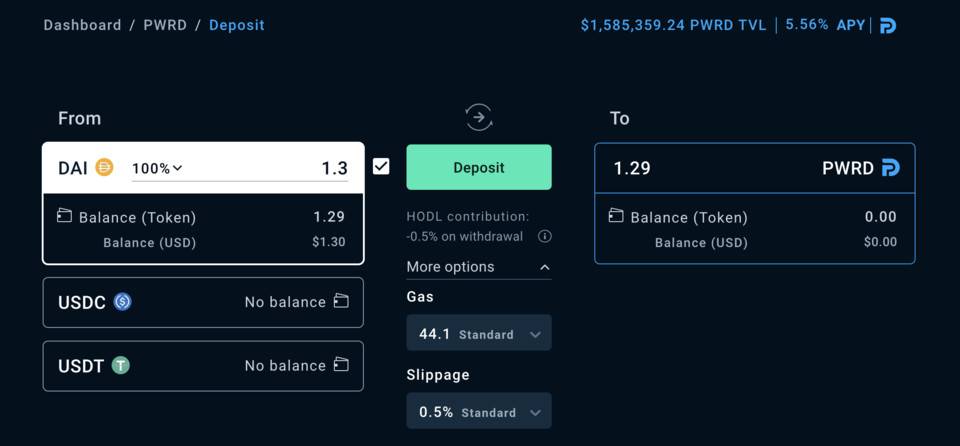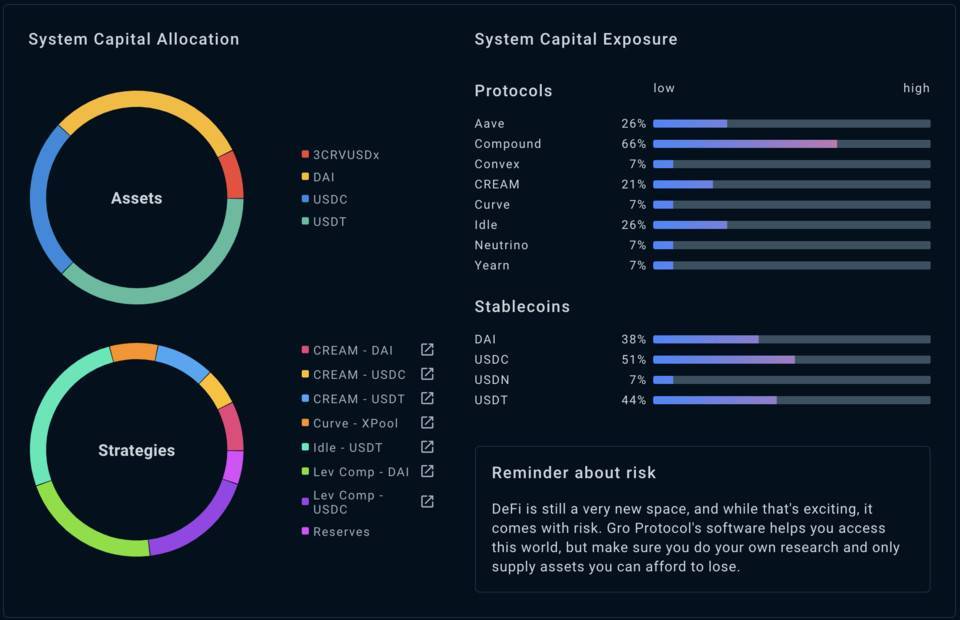How does the Yield Layering Protocol Gro implement products with high and low risk structures?
Written by: Karen
As the DeFi market gradually returns to rationality from its initial frenzy, the high volatility that crypto assets have long struggled with forces yield farmers to start looking for more "robust" shovels. For this reason, yield farming based on stablecoins has suddenly become the new darling of the market.
Today, Chain News introduces Gro, a stablecoin yield layering protocol that offers products more aligned with the risk preferences of two types of investors. Investors in the high-yield product Vault must bear the loss risks of the low-risk product PWRD, similar to the traditional tiered fund structure, where a revenue-sharing mechanism drives synergy between the two products to achieve balance.
Currently, Gro is still in the Beta testing phase and has been integrated into Argent and WalletConnect. The previous restrictions on investors' Degen Scores have been lifted, and the hard cap for Vault's locked amount has been raised to $10 million, while the hard cap for PWRD's locked amount has been raised to $6 million. The current total locked amount in the protocol has reached approximately $6.65 million.
What is Gro?
Founded in August 2020, Gro is a stablecoin yield aggregator that provides services with different risk levels and yields based on its layering mechanism and users' individual risk preferences. It currently offers two complementary products: the low-risk stablecoin savings product PWRD and the higher-risk stablecoin yield product Vault.
Because Gro has introduced risk layering and revenue-sharing mechanisms, it means that yields will be shared and distributed between Vault and PWRD. While Vault carries higher risks, it can also yield higher returns.
Although the Gro team is not anonymous, the main members have not yet been publicly disclosed. However, Gro's technical documentation indicates plans to update the team page on its official website and is currently recruiting senior developers and engineers. Gro has also undergone a security audit conducted by PeckShield and Fixed Point Solutions (Kurt Barry).
Additionally, Gro completed a $7.1 million seed round financing led by Galaxy Digital and Framework Ventures in March of this year, with participants including Variant, Northzone, Nascent, a_capital, and 3AC.
Gro Product Operating Model
The operating model of Gro's products is that users only need to deposit DAI, USDC, or USDT stablecoins into PWRD or Vault, and then Gro will utilize these funds to engage with other third-party DeFi protocols to enhance yields, with the returns shared and distributed between the two products.
While Vault aims for higher yields, it must bear all risks associated with both Vault and PWRD products. PWRD is a low-risk savings product, where users receive token shares called PWRD after depositing the aforementioned three stablecoins. On the other hand, PWRD can also serve as a medium for exchange like other stablecoins for sending and consumption.
Due to the synergistic interaction between Vault and PWRD, we will next explain the low-risk protection mechanism of PWRD, the yield strategies of PWRD and Vault, the stablecoin mechanism of PWRD, and Gro's risk layering characteristics one by one.
How Does PWRD Ensure Low Risk?
The low risk here can be discussed from two aspects. From the perspective of user principal assets, users only provide stablecoins and will not be affected by significant market fluctuations.

More importantly, PWRD also provides a deposit protection mechanism that can prevent risks associated with the stablecoins themselves or smart contracts. Of course, this mechanism also aims to incentivize users of the higher-risk Vault.
In other words, if any of the stablecoins DAI, USDC, or USDT experiences a failure or decouples from the dollar, or if the third-party DeFi protocol used fails, or if the Gro protocol incurs losses using third-party DeFi protocols, then Vault holders will bear the losses to protect PWRD. However, if substantial yields can be obtained, Vault users can also enjoy higher returns. Therefore, Gro products also set a hard cap on the locked amount.
Sources of Yield for PWRD and Vault
Gro will utilize all funds deposited in the two products to generate yields through third-party DeFi protocols, with yields primarily coming from three aspects: loan income, transaction fees, and protocol rewards, specifically:
- Funds are placed in lending protocols like Aave and Compound to generate interest;
- Deposited into automated market-making protocols like Uniswap and SushiSwap to provide liquidity and earn transaction fees;
- Using DeFi protocols like Curve and Balancer to earn token incentives, which Gro converts into user yields after claiming and selling these rewards.
In addition, long-term participants in Gro products will also receive another portion of income, which is a 0.5% fee paid by users when withdrawing funds from Vault or selling PWRD to other holders. This not only attracts user participation but can also help maintain user locked amounts to some extent in the medium to long term.
Moreover, Gro currently does not charge performance fees, but this may change due to governance.
So how does Gro allocate assets and balance risks among third-party DeFi protocols? Gro will regularly update its DeFi yield strategies, and one notable advantage is its proprietary Risk Balancer.
This is a module that automatically balances asset portfolios, integrated with Gro's deposit and withdrawal mechanisms, allowing Gro to diversify risks and gain diversified risk exposure between stablecoins and various DeFi protocols that serve as yield sources. It will also distribute yields between PWRD and Vault through risk and yield layering mechanisms.

The high-yield product Vault's portion of the yield obtained from PWRD depends on the utilization rate (the ratio of PWRD locked amount to Vault locked amount). The higher the utilization rate, the higher the yield. Specifically, when the utilization rate is below 80%, Vault holders can receive a basic rate of 30% of PWRD user yields.
Adding 3/8 of the utilization rate gives: 30% + 3/8 * utilization rate; if the utilization rate exceeds 80%, they will receive a basic rate of 60% plus double the value of the utilization rate minus 80%, calculated as: 60% + 2(utilization rate - 80%).

For PWRD, after depositing DAI, USDC, and USDT stablecoins into the product, it is displayed as PWRD stablecoin. PWRD stablecoin has a Rebase mechanism, and when a Rebase occurs, if the yield generated by the protocol strategy exceeds a certain threshold, the supply of PWRD will increase algorithmically, automatically distributed to PWRD holders' wallets. As mentioned earlier, any potential losses are first borne by Vault.
How Does Gro Achieve Risk Layering?
As mentioned earlier, the risks and yields of PWRD and Vault differ. Additionally, Gro allows users to further layer their risks, meaning they can transfer yields from one product to another in exchange for more protection or returns. Although both cannot be obtained simultaneously, users can manage their acceptable risks and yields according to their preferences.
This means that when the ratio of PWRD locked amount to Vault locked amount (utilization rate) is low, the lower protection cost makes PWRD more attractive, while when the utilization rate is high, the higher-yield Vault will be more popular.
Conclusion
Compared to other yield protocols currently on the market, Gro has significant advantages in the interactivity of risk layering, diversity of investment portfolios, and deposit protection mechanisms. It can be imagined that as more assets are deposited into PWRD, the yields obtained by Vault will increase, and as more funds are deposited into Vault, PWRD will enjoy better protection. This characteristic of Vault product users acting as protectors for PWRD and the synergistic complementarity of the two products may enable Gro to develop further.












